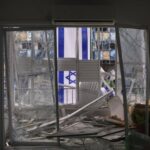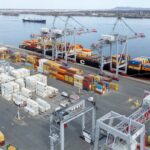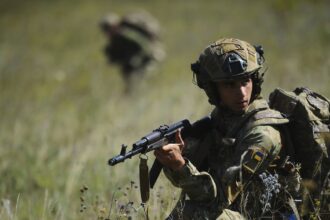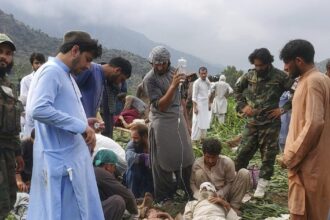The geopolitical landscape of the Middle East erupted into a new phase of conflict early Sunday as U.S. forces conducted precision strikes against three Iranian nuclear facilities, marking a dramatic escalation in regional tensions. Former President Donald Trump, now serving his second non-consecutive term, confirmed the military action in a brief but decisive statement from the White House Situation Room.
“At my direction, U.S. strategic forces have successfully targeted and degraded Iran’s nuclear weapons program,” Trump announced, flanked by military leaders. “These precision strikes were conducted in coordination with our Israeli allies and represent our unwavering commitment to preventing Iran from obtaining nuclear weapons capability.”
The strikes, which reportedly began at approximately 3:00 AM local time in Iran, targeted facilities in Natanz, Fordow, and a previously undisclosed site near Qom. Pentagon officials confirmed that B-2 stealth bombers delivered bunker-busting munitions designed to penetrate the heavily fortified underground complexes where uranium enrichment activities were allegedly taking place.
Satellite imagery analyzed by defense experts shows substantial damage to above-ground structures at all three sites, though the extent of destruction to subterranean facilities remains unclear. Iranian state media has acknowledged the attacks while vehemently denying that the targeted facilities housed nuclear weapons development programs.
“This unprovoked act of aggression against sovereign Iranian territory will not go unanswered,” declared Iranian Supreme Leader Ayatollah Ali Khamenei in an emergency television address. “The Islamic Republic reserves the right to defend itself against American and Zionist terrorism.”
International reaction has been swift and divided. While Israeli Prime Minister Benjamin Netanyahu praised the operation as “essential to regional security,” European leaders have expressed concern about the unilateral nature of the strikes. French President Emmanuel Macron called for an emergency UN Security Council meeting, while German Chancellor Olaf Scholz urged “maximum diplomatic restraint from all parties.”
The military action follows months of escalating tensions after Iran announced its withdrawal from the remnants of the Joint Comprehensive Plan of Action (JCPOA) in January 2025. International Atomic Energy Agency inspectors were subsequently expelled from the country, raising alarm among Western intelligence agencies about accelerated uranium enrichment activities.
Defense Secretary Lloyd Austin, speaking at a hastily arranged press conference, emphasized that the strikes were specifically targeted to minimize civilian casualties while maximizing damage to Iran’s nuclear infrastructure. “These precision operations were the culmination of months of intelligence gathering and operational planning,” Austin stated. “We have high confidence that we’ve significantly degraded Iran’s ability to produce weapons-grade nuclear material.”
Oil prices surged more than 15% in early trading following news of the strikes, with Brent crude exceeding $120 per barrel for the first time since 2022. Financial analysts warn that prolonged regional instability could drive energy prices even higher, potentially impacting global economic recovery efforts.
The Biden administration had maintained a policy of diplomatic engagement with Iran during its term, but the Trump administration’s return to power in January signaled a dramatically different approach. During his campaign, Trump repeatedly criticized the remnants of the nuclear deal as “catastrophically weak” and promised a more confrontational stance toward Tehran.
As tensions escalate, military analysts are closely watching for signs of Iranian retaliation, which could potentially target U.S. forces stationed throughout the Middle East or Israeli population centers. The Pentagon has already announced heightened alert status for American military installations across the region and deployed additional naval assets to the Persian Gulf.
As the world holds its breath for Iran’s response, the critical question remains: Will these strikes truly prevent Iran’s nuclear ambitions, or have they instead set the stage for a wider and potentially more devastating regional conflict?














